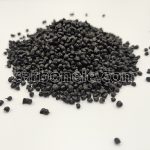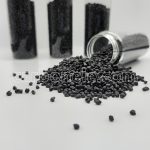
Top Quality PPA CF5 Thermoplastics
PPA CF5 is a composite material combining Polyphthalamide (PPA) with 5% carbon fibers. It enhances strength, stiffness, and thermal resistance, suitable for lightweight, high-performance applications in automotive, aerospace, and industrial sectors
- Model: PPA-CF-BCA05
- Matrix resin: Phenylpropanolamine
- Filler: Carbon fiber
- Manufacturer: Yes
- OEM: Supported
- Free sample: 1-25kgs
What are PPA CF5 thermoplastics?
PPA CF5 refers to a composite material consisting of Polyphthalamide (PPA) reinforced with 5% carbon fibers.
This composition merges the advantageous properties of PPA with the enhanced mechanical characteristics provided by carbon fibers, resulting in a versatile material suitable for various demanding applications across different industries.
To understand PPA CF5 comprehensively, let’s explore its composition, properties, manufacturing processes, applications, and advantages in detail.
Composition and Structure
PPA CF5 combines two main components:
1. Polyphthalamide (PPA):
– PPA is a high-performance engineering thermoplastic known for its excellent mechanical properties, including high tensile strength, stiffness, and resistance to heat and chemicals.
– It exhibits good dimensional stability and can withstand temperatures typically up to around 200°C (392°F), depending on the specific grade.
2. Carbon Fiber Reinforcement:
– Carbon fibers are lightweight, extremely strong materials derived from precursors like polyacrylonitrile (PAN) or pitch.
– Incorporating carbon fibers into PPA enhances the composite’s mechanical properties, including tensile strength, stiffness, and fatigue resistance.
Properties
PPA CF5 exhibits a balanced set of properties:
1. Mechanical Properties:
– Enhanced Strength: Although the carbon fiber content is relatively low (5%), it still contributes to improved tensile strength compared to unfilled PPA.
– Increased Stiffness: Carbon fibers enhance the modulus of elasticity, providing stiffness crucial for structural applications.
– Fatigue Resistance: The reinforcement with carbon fibers enhances the composite’s ability to withstand cyclic loading and fatigue, making it suitable for dynamic applications.
2. Thermal Properties:
– High Temperature Resistance: PPA CF5 retains its mechanical properties at elevated temperatures, making it suitable for applications requiring thermal stability.
– Thermal Expansion: The coefficient of thermal expansion of it is influenced by the PPA matrix and the orientation of carbon fibers, affecting dimensional stability under temperature changes.
3. Chemical Resistance:
– PPA CF5 exhibits good resistance to various chemicals, oils, and fuels, making it suitable for applications where exposure to harsh environments is expected.
4. Electrical Properties:
– The addition of carbon fibers can influence the electrical conductivity and dielectric properties of it, which is important in certain electronic and automotive applications.
Manufacturing Processes
The production of PPA CF5 involves several key processes:
1. Compounding: PPA resin and carbon fibers are compounded together to ensure uniform distribution of fibers within the polymer matrix.
2. Molding: The compounded material can be processed using techniques such as injection molding, compression molding, or extrusion depending on the desired final product and application requirements.
3. Post-processing: After molding, parts may undergo additional treatments such as machining, surface finishing, or heat treatment to achieve specific mechanical and dimensional properties.
Applications of PPA CF5
Application in various industries:
1. Automotive:
– Used in automotive components such as brackets, housings, and engine parts where a balance of strength, stiffness, and thermal resistance is required.
2. Aerospace:
– Components in aircraft interiors and structures where lightweight materials with high mechanical performance and durability are essential.
3. Industrial:
– Machinery components, tooling, and equipment requiring robust materials that can withstand demanding operational conditions.
4. Electronics:
– Enclosures, connectors, and structural components in electronic devices where lightweight materials with good mechanical and thermal properties are advantageous.
5. Consumer Goods:
– Sporting equipment, consumer electronics, and appliances benefiting from the lightweight and durable characteristics of PPA CF5.
Advantages of PPA CF5
1. Weight Reduction: The incorporation of carbon fibers allows for lightweight constructions, which is beneficial for applications requiring weight savings.
2. Enhanced Mechanical Performance: Compared to unfilled PPA, the compound offers improved strength, stiffness, and fatigue resistance, extending the lifespan of components.
3. Dimensional Stability: PPA CF5 maintains dimensional integrity under varying temperature conditions, ensuring precise fit and function over time.
4. Versatility: It can be tailored to meet specific application requirements through adjustments in fiber orientation, resin formulation, and manufacturing processes.
Conclusion
PPA CF5 represents a versatile composite material that leverages the strengths of Polyphthalamide (PPA) and carbon fiber reinforcement.
With enhanced mechanical properties, thermal stability, and chemical resistance, it finds widespread use in automotive, aerospace, industrial, and consumer sectors.
As materials science continues to advance, it remains a key contender for applications demanding high-performance materials that balance strength, stiffness, and durability.
Content Block 1
Morbi iaculis at quam vel faucibus. Ut semper ipsum ex, quis aliquet justo pretium a. Suspendisse scelerisque metus augue, a interdum leo iaculis sed. Vivamus sit amet nunc odio. Duis vel pulvinar dolor, at lacinia tellus.
Pellentesque habitant morbi tristique senectus et netus et malesuada fames ac turpis egestas. Suspendisse lacinia quam a elit lobortis tempor


Content Block 1
Morbi iaculis at quam vel faucibus. Ut semper ipsum ex, quis aliquet justo pretium a. Suspendisse scelerisque metus augue, a interdum leo iaculis sed. Vivamus sit amet nunc odio. Duis vel pulvinar dolor, at lacinia tellus.
Pellentesque habitant morbi tristique senectus et netus et malesuada fames ac turpis egestas. Suspendisse lacinia quam a elit lobortis tempor

Frequently Asked Questions
Carbon (Xiamen) New Material Co., Ltd. aims to provide buyers with "one-stop" worry-free high-quality services. Here you can find all information about carbon fiber engineering plastics. If you still have questions, please send us an email for consultation!
-
How can I contact the manufacturer of a product that interests me?
When you find a product you are interested in, you can contact the manufacturer directly by sending an email and we will get back to you as soon as possible.
-
How do I find the products that interest me?
All you need to do is enter the keyword, product name in the search window and press the Enter key on your keyboard. Your search results page will then be displayed. You can also search within the product category pages on the home page. Each category is divided into subcategories, allowing you to refine your search and find products that interest you.
-
Where will I find a buying guide?
Please contact our after-sales service directly and we will provide you with a comprehensive operating guide.
-
What are CF Reinforced Thermoplastic Composites?
CF Reinforced Thermoplastic Composites are materials where carbon fibers are incorporated into a thermoplastic matrix. They combine the strength and stiffness of carbon fibers with the processability and recyclability of thermoplastics. For instance, they are used in automotive parts like bumper beams.
-
What are the benefits of CF Reinforced Thermoplastic Composites over traditional composites?
The key benefits include faster production cycles, easier recyclability, and better impact resistance. They also offer design flexibility. An example is in the manufacturing of consumer electronics casings where complex shapes can be achieved more easily.
-
How are CF Reinforced Thermoplastic Composites processed?
Common processing methods include injection molding, extrusion, and compression molding. Injection molding is widely used for mass production. For example, in the production of small components for the medical industry.
-
What industries use CF Reinforced Thermoplastic Composites?
They are utilized in aerospace, automotive, medical, and sports equipment industries. In aerospace, they can be found in interior components. In the medical field, they might be used in prosthetics.
-
How does the carbon fiber content affect the properties of the composites?
Higher carbon fiber content generally leads to increased strength and stiffness but may reduce ductility. A moderate content is often balanced for specific applications. For example, a higher content might be preferred in structural parts of a race car.
-
What are the challenges in using CF Reinforced Thermoplastic Composites?
Challenges include higher material costs, complex processing equipment requirements, and ensuring uniform fiber dispersion. Issues with adhesion between the fibers and the matrix can also arise. An example is in achieving consistent quality in large-scale production.

























